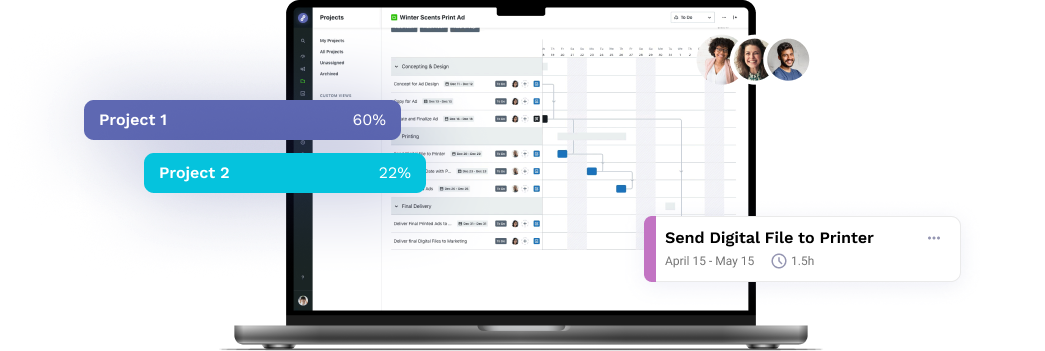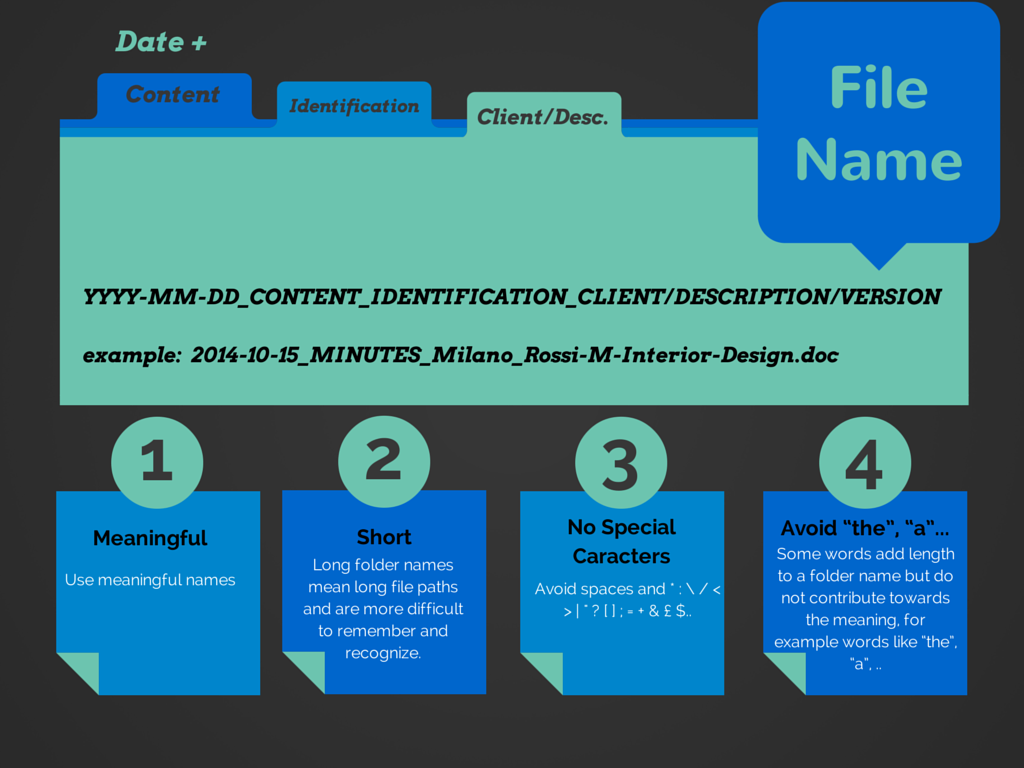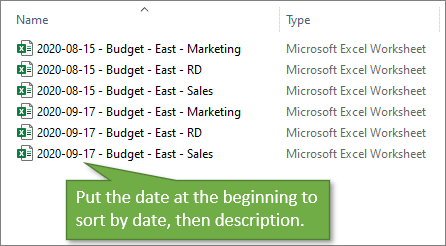
File naming conventions may not be the most exciting topic, but they’re essential. Without a clear system, creative teams waste time digging through files instead of focusing on their work.
As workloads grow, saving time wherever possible becomes even more important. In fact, over 70% of creative teams we surveyed said managing speed and volume remains a major challenge.
The good news is that we’ve got you covered. This guide breaks down everything you need to know about naming conventions, from the basics to best practices that will keep your files organized and easy to find.
What Are Naming Conventions?
According to the Harvard Medical School Research Data Management Department, file naming conventions are “frameworks for naming your files in a way that describes what they contain and how they relate to other files.” The idea is to follow a pattern in naming all of your assets.
When you do this consistently, your files will be easier to find. Using this logic, programmers have built a plethora of digital asset management solutions that cater to the needs of marketing and creative teams.
Why Are Naming Conventions Important?
Naming conventions provide at least three vital benefits.
1. They Bring Consistency and Efficiency
Consistency is a universal human trait. In fact, we love organization! It is one of the key drivers behind our successes and proliferation as a species.
Importantly, consistency permits greater accuracy and efficiency for repeatable excellence. When your team has a regular way of doing things that they understand and don’t have to think too hard about, they can put their minds on the finer points of the creative tasks at hand.
Also, staying organized and consistent demonstrates reliability, which breeds trust and stability. No wonder then that categorizing assets in a predictable and consistent way feels right.
2. They Improve Findability and Searchability
If you want others to see, use, and appreciate the materials you’ve worked hard on, you have to make it easy for them to find them. Practical naming conventions ensure your assets get full use because they increase searchability and findability.
Imagine someone needs an image or visualization that illustrates a concept and yours doesn’t show up with the appropriate search terms. They may just use something else that’s not as good. Solid naming conventions consider predictability in how people search so you can create a network of assets that are all easy to locate.
3. They Offer Transparency and Alignment
Everybody has a better idea of what’s available and how projects are going when you have naming conventions that you’ve thoughtfully constructed and consistently applied. That may not be true when you leave naming up to each person’s preferences.
Create a standard naming convention for your assets so everyone uses a common language when they refer to projects and campaigns. Such transparency leads to fewer questions and enhanced teamwork.
How Naming Conventions Support Brand Consistency
Brand consistency is more than just using the right colors and logos. It also keeps your assets organized and easy to find.
Without a standardized naming system, creative teams risk misusing outdated assets, duplicating work, or creating inconsistencies across campaigns.
A clear naming convention ensures that every asset follows the same structure, making it easier for teams to maintain a cohesive brand identity. Whether it’s a social media graphic, a presentation, or an email template, naming conventions help teams quickly identify the most up-to-date and approved versions of assets.
Imagine a marketing team working on a product launch. If one designer labels files with product names while another uses generic terms like “Final_Version2,” chaos follows. A structured naming system removes the guesswork, ensuring that everyone — from designers to marketing managers — can confidently pull the right files when they need them.
By establishing and following a consistent naming structure, teams can streamline workflows, reduce errors, and ensure every piece of content aligns with brand guidelines. It’s a simple yet powerful way to keep branding on track while freeing up time for more creative work.
What’s a Good Example of Naming Conventions?
Let’s say you work for a creative agency that deals with multiple clients every week. A beneficial naming convention framework could look like this:
-
Create a separate folder for each of your clients on your desktop.
-
Add subfolders inside the original folders for each content medium, like web, printed, and email.
-
Include a separate subfolder for each content medium project, e.g. Website Rebrand.
-
Add one or more subfolders that categorize content by year, month, and content subtype.
-
Compress all your wonderful work into a single, zipped file so you can share everything quickly.
Of course, you’ll devise your own system. Whatever tactics you find to be practical for naming your files and folders, formalize them for success.
What’s the Best Way to Organize Your Work?
Use these best practices to create tailored naming conventions.
1. Do What Works for You
The naming conventions framework you need largely depends on the nature of your business. For example, the industry you’re in will dictate the vocabulary and abbreviations you use.
Discuss what’s most important with stakeholders to build a system that works for your team. The best naming convention is one that considers your team’s specific needs and work characteristics.
If your team likes to organize work for a client or department, it can be useful to put some information about whom the work is for in the name. On the other hand, if you are an in-house creative team that works solely with the marketing department, you might prefer a different strategy.
2. Include the Details That Matter
It’s helpful to include something relating to the project type or other details that your team will want to see at a glance. For example, is the work a rush job? This can also be an area for flexibility and customization.
Potential elements for your naming conventions include:
-
Content Title: Consider your naming format and whether you’ll use spaces, hyphens, or dashes between words.
-
Content Medium: Define what content type your asset falls under, such as landing page, blog post, campaign email, or article.
-
Client Name: Where applicable, adding your client’s name makes it quicker to find everything you have worked on for a specific client at a glance.
-
Project Name: Adding the name of a project can assist with finding items that belong to the same initiative in an instant, but might be tricky for assets belonging to many different projects.
You may have other details specific to your team, so leave room for descriptive creativity.
3. Make It a Date
Knowing something about the when of a project can be incredibly useful, whether that’s the start date, due date, submitted date, or even what month or quarter you worked on it. When doing so, it’s best to use the convention YYMMDD for dates. You can more easily order items chronologically that way than the U.S. standard of MMDDYY.
4. Numbers Don’t Lie
An advanced option is to incorporate a numbering system into your naming conventions. Beyond dates, it could be as simple as counting the number of projects that year, starting at 1.
You could even include advanced information, like department or product codes. Fortunately, Lytho’s Creative Workflow provides auto-numbering to help teams assign numerical codes to project and campaign names.
5. Order Matters in Building Naming Conventions
Think carefully about the order of your elements in your naming convention. For example, if you follow the date convention of YYMMDD, put that at the beginning of your name to make it easy to sort items chronologically. If you put the date at the end, you will lose some sorting ability.
The question you should ask is, “What purpose does each element serve?” Then build the convention accordingly.
6. Find Your Balance
Length is an important consideration in your naming conventions. Never make the name too long. You need a balance of being long enough to have meaning and distinguish the campaign or project from others, but not so long that it becomes cumbersome.
How Automation Simplifies Naming Conventions
Even with the best intentions, sticking to a naming convention can be a challenge. People get busy, deadlines creep up, and before you know it, files end up labeled with random names like “Final_Version_REALFINAL.”
Automated naming tools take the guesswork out of file organization by applying pre-set rules to every project and asset. Instead of relying on individuals to remember naming conventions, automation ensures consistency from the start. This reduces human error, eliminates duplicate work, and makes it easier to locate the right files when needed.
For example, Lytho’s Creative Workflow allows teams to set up auto-naming rules that apply across all assets. Need to include project names, dates, or specific tags? Automation handles it — no extra effort required. That means less time spent renaming files and more time focused on creative work.
By integrating automation into your naming conventions, you streamline your workflow, improve collaboration, and ensure that every file follows the right structure. No more searching through endless versions — just an organized system that works for you.
Streamline Your Workflow Today With Lytho
Once you have a naming convention, the key is to use it consistently. Lytho’s Creative Workflow makes this easy with auto-naming, applying set rules to every project and asset automatically. This keeps files organized, reduces confusion, and streamlines workflows — so your team can focus on creating instead of searching for the right file.
Free up more time for creativity by automating the tedious tasks. See how Lytho streamlines workflows and keeps your brand assets organized. Schedule a demo today!
Do you want to give yourself and your creative team more room for creative stimulation by automating the boring stuff? Lytho helps you streamline your entire workflow and harmonize all brand collateral under a single, uniform platform. Feel free to reach out to us by scheduling a demo and learning how our creative solutions can boost the effectiveness of your creative projects. We look forward to speaking with you!

Ready to simplify your creative operations and start having a little fun at work again? Schedule time to talk with us.
Let us show you how Lytho’s Creative Operations Platform helps in-house creative and marketing teams do better work, ease the stakeholder experience, and stay on brand.
Schedule a Demo
